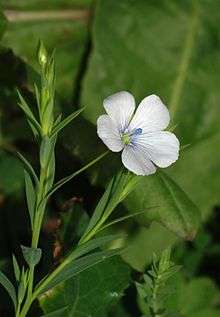Linum bienne
| Pale flax | |
|---|---|
 | |
| Scientific classification | |
| Kingdom: | Plantae |
| (unranked): | Angiosperms |
| (unranked): | Eudicots |
| (unranked): | Rosids |
| Order: | Malpighiales |
| Family: | Linaceae |
| Genus: | Linum |
| Species: | L. bienne |
| Binomial name | |
| Linum bienne Mill. | |
| Synonyms[1] | |
| |
Linum bienne (pale flax[2]) is a flowering plant in the genus Linum, native to the Mediterranean region and western Europe, north to England and Ireland.
Pale flax grows as a biennial or perennial plant in dry, sunny calcareous or neutral grasslands from sea level up to 1000 m. It has long, narrow stems to 60 cm tall and slender leaves 1.5-2.5 cm long. The flowers have five petals about 1 cm long and nearly round; they are pale blue but streaked with darker colour. It flowers in late spring and, at least in more temperate regions, through the summer. The flowers are monoecious and are pollinated by bees and wasps.
Linum bienne (=L. angustifolium) is considered the probable wild forebear of the cultivated flax,[3] and a fibre can be made from its stem. It is sometimes grown as a garden plant.
It has been introduced into North America, where it is naturalized on the Pacific coast from Oregon to the central coast of California, and also in Pennsylvania; it is found in Hawaii, as well.
References
- ↑ "The Plant List: A Working List of All Plant Species". Retrieved 3 October 2014.
- ↑ "BSBI List 2007". Botanical Society of Britain and Ireland. Archived from the original (xls) on 2015-02-25. Retrieved 2014-10-17.
- ↑ Allaby, R.; Peterson, G.; Merriwether, D.; Fu, Y.-B. (2005). "Evidence of the domestication history of flax (Linum usitatissimum L.) from genetic diversity of the sad2 locus". Theoretical and Applied Genetics. 112 (1): 58–65. doi:10.1007/s00122-005-0103-3.
- Blamey, M. & Grey-Wilson, C. (1989). Illustrated Flora of Britain and Northern Europe. Hodder & Stoughton.
- Huxley, A. (1992). New RHS Dictionary of Gardening vol. 3: 93. Macmillan.